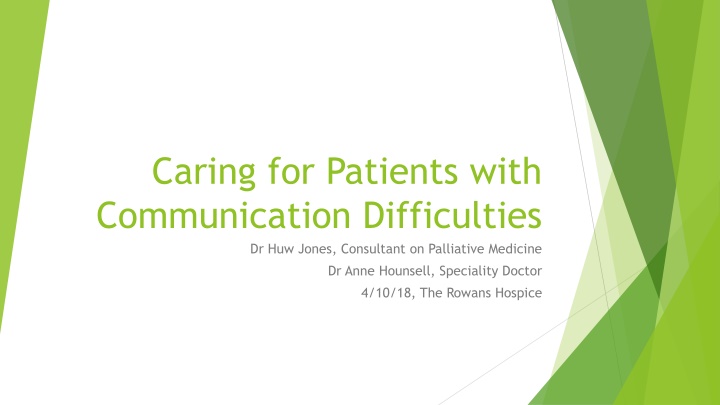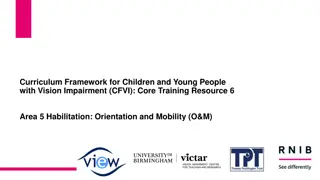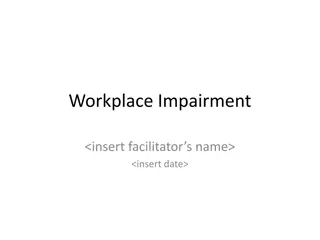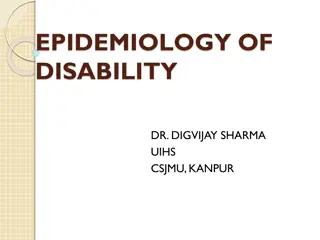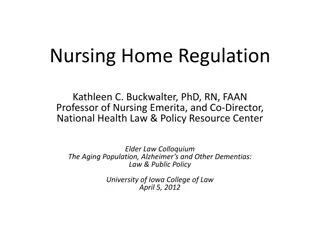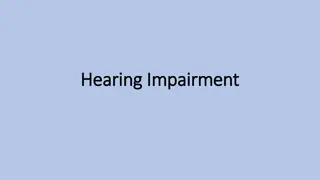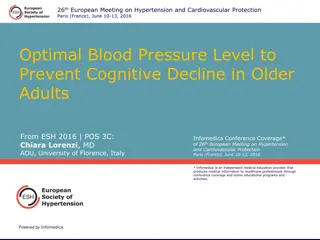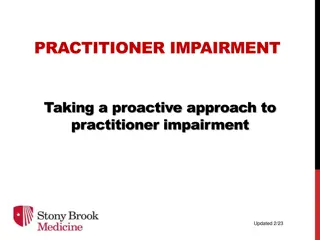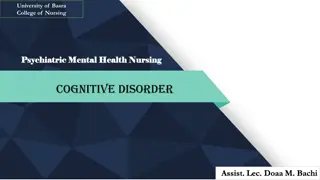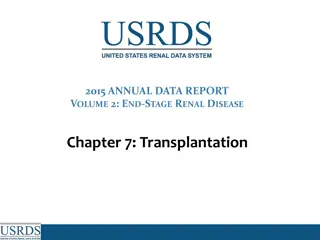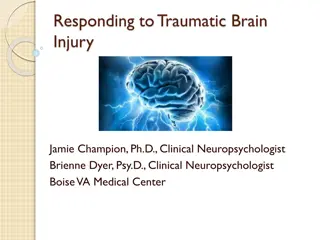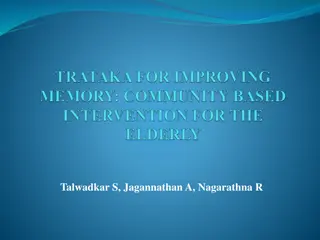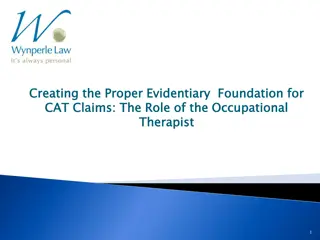Communicating with Patients with Cognitive Impairment and Other Communication Difficulties
This presentation highlights the causes of communication difficulties in patients, focusing on cognitive impairment, sensory impairments, and language barriers. It emphasizes the challenges of caring for these patients, including assessing pain and managing symptoms effectively. Practical strategies for improving communication such as speaking clearly, using non-verbal methods, and involving translators or family members are discussed. The unique needs of patients with cognitive impairment at the end of life are also addressed, stressing the importance of education, collaboration, and small adjustments in care practices.
Download Presentation

Please find below an Image/Link to download the presentation.
The content on the website is provided AS IS for your information and personal use only. It may not be sold, licensed, or shared on other websites without obtaining consent from the author.If you encounter any issues during the download, it is possible that the publisher has removed the file from their server.
You are allowed to download the files provided on this website for personal or commercial use, subject to the condition that they are used lawfully. All files are the property of their respective owners.
The content on the website is provided AS IS for your information and personal use only. It may not be sold, licensed, or shared on other websites without obtaining consent from the author.
E N D
Presentation Transcript
Caring for Patients with Communication Difficulties Dr Huw Jones, Consultant on Palliative Medicine Dr Anne Hounsell, Speciality Doctor 4/10/18, The Rowans Hospice
OBJECTIVES A reminder of the different causes of communication difficulties. The challenges of caring for these patients. Assessing pain in patients with cognitive impairment. (feedback from the Oxford Pain and Advanced Symptom Management Course, July 18) Extrapolation of the above to other aspects of patient care.
Causes of communication difficulties Cognitive Impairment EG learning difficulties (LD), dementia, delirium, some mental health conditions, CVA, brain tumours. Sensory Impairments Vision, hearing Language barriers Different languages, expressive dysphasia, illiteracy, inability to speak (eg patients with laryngeal cancer patients or MND) Others Receptive dysphasia, reduced level of consciousness (including the dying phase) Most conditions of course will affect several of the above simultaneously
What can we do to help us communicate with (and therefore care for) these patients? General ideas eg: Speak slow and clear, louder if needed. Positioning Clear questions, small chunks of information at a time. Non verbal communication eg writing, light writer, eye gaze system, picture board Translator Collateral from family/carer Proactive planning, MDT, confidence in creative approach
Cognitive Impairment (CI) Definition the loss of intellectual function lack of effective thinking Challenges in General Patients with CI are vulnerable. Unfortunately the symptom management needs of vulnerable patients at the end of life are poorly understood. There is a lack of recent research for patients with LD. Most research is from dementia patients. Also challenging behaviour, physical co-morbidities and some issues with compliance to management. Capacity (decision specific) issues. The patients can have difficulties understanding and coping with their palliative condition. Assessment can be challenging eg they may have difficulty perceiving/ expressing pain. HCP s can be overwhelmed or anxious about how to care for their patients with their perceived differences and difficulties. There is a lack of experience in caring for patients with LD.
Cognitive Impairment continued -The fundamentals of care remain the same but adjustments often needed. -Need to remember that patients with CI at end of life have more similarities than differences. -Education and collaboration may be the key to effective support and small changes in practice could improve patient experience
One aspect of our patient care is of course symptom assessment. These can be challenging . We will look at the assessment of pain as an example. But of course the techniques can be applied to other symptoms.
Assessing pain. Pain is what the patient says it is and occurs when he/she says it does . Mc Caffery 1979 But what if the patient cannot say? The following youtube clip PAINAD 2 communication demonstration
Does this seem familiar? What did you do? How did you assess him/her?
Assessment of pain Principles : 1)Self reporting (gold standard for ALL patients). Informal questions and use of scales/tools 2)Observe behaviour 3)Examine for possible causes of pain 4)Gain report from family/carer. The family have a key role in supporting the patient. We must also remember to look at the affective dimension, ie how it affects mood, emotions etc, and its impact (eg on washing , dressing, mobility)
NICE guidance Pain in Patients with Cognitive Impairment Consider using a structured observational pain assessment tool. Use alongside self-reported pain and standard clinical assessment for people living with moderate to severe dementia Use alongside standard clinical assessment for people living with dementia who are unable to self-report pain. For people living with dementia who are in pain, consider using a stepwise treatment protocol that balances pain management and potential adverse events. Repeat pain assessments for people living with dementia: -who seem to be in pain -who show signs of behavioural changes that may be caused by pain -after any pain management intervention.
Symptom Assessment tools for pain SELF REPORT SCALES What have you seen used?
Visual analogue scale/Numerical rating scale 0-10 severity Validated for mild/moderate CI
Wong Baker faces scale Faces with expressions indicating different levels of pain Validated up to moderate CI, but requires an understanding of emotions.
Visual Rating scale No pain, moderate pain, worst possible pain Can be used for all severities of CI. The most successful No pain Mild Moderate pain Intense pain Maximum pain pain
Symptom Assessment tools for pain Observational Scales What are the main principles? What have you have used /seen used?
Symptom Assessment tools for pain Observational Scales Looking at verbal and behavioural indicators that can be used to measure distress. Includes looking at : posture facial features at rest and then with pain eg grimace, agitation. are they protecting part of their body? Also inclusion of physiological observations eg HR, BP etc but these not very specific.
PAINAD Pain assessment tool in advanced dementia 0 1 2 Breathing Normal Occasionally laboured. Short period of hyperventilation Noisy laboured breathing Long periods of hyperventilation Cheyne stokes breathing Negative vocalisation None Occasional moan/groan Low level speech with negative or disapproving quality Sad, frightened, frowning Repeated troubled calling out. Load moaning or groaning. Crying grimacing Facial expression Smiling or Inexpressive Body language Relaxed Tense or fidgeting Distressed pacing Rigid, fists clenched. Knees pulled up. Pushing or pulling away. Striking out Unable to console, distract or reassure consolability No need Distracted or reassured by voice or touch
Disability Distress Assessment Tool (DISDAT) Not a scoring system, more a systematic descriptive summary. Appearance/vocalisation/habits/mannerisms/posture/obs ervations are described for when content (as baseline) and when distressed Whole team assessment Compare over time. Keep in mind known triggers.
Summary of Pain Assessment in Patients with Cognitive Impairment Pain is what the patient tell us it is, but this is complex when CI impairment is present. Self-report is the 1ststep -use the appropriate PAT Self-report relies on the patients willingness to communicate and ability, consider how you communicate with these groups. If necessary, you should then refer to observational PATs. All PATs have their limitations, however it is recommended they are always used, providing we use them appropriately (NICE) PATs should be used in conjunction with the patients history, feedback from carers or family members and your clinical knowledge. Consistently use one, and use after intervention also. Education is needed to enhance the use of these tools.
Summary A reminder of the different causes of cognitive impairment. The challenges of caring for patients with communication difficulties. Those with communication challenges. How do we assess pain in those with cognitive impairment? Extrapolation of the above to other aspects of caring for these patients
THANKYOU FOR LISTENING! ANY QUESTIONS
References E ELCA website (end of life care for all) Oxford Course NICE SIGN American Pain Society Palliative Care for people with intellectual disabilities: pitfalls and potential Palliative Medicine editorial -27 (1) -2012. UK Guidelines (2018) (evidence from Kelley, Siegler, & Reid, 2008; Pesonen, Kauppila, Tarkkila, Sutela, Niinisto, & Rosenberg, 2009). IASP (international association for the study of pain) For UK guidelines see: The Assessment of Pain in Older People: UK National Guidelines Pat Schofield. Age and Ageing, Volume 47, Issue suppl_1, 1 March 2018 EFIC (European pain Federation) Australian pain society
Appendix 1 other pain Assessment tools Memorial pain assessment card Pain scale least to worst possible 1) Pain description scale circle any of moderate, mild, weak, excruciating, severe, no pain, just noticeable 2) Brief Pain Inventory Questionnare looking at rating scales, effect of medication and effect on functional status and quality of life The Mc Gill pain questionnaire Global and subscale scores that reflect the sensory, affective and evaluative dimensions of pain
